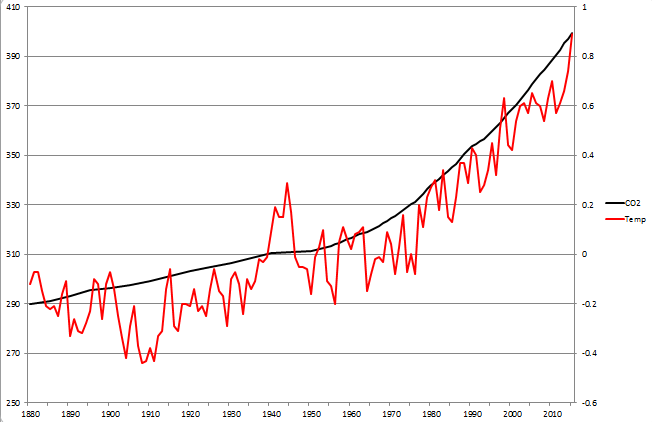The environment comes first, so we must drive down transport CO2
Local Transport Today, March 18th 2016

The environment comes first, so we must drive down transport CO2Local Transport Today, March 18th 2016 |
 |
The interview with Benny Peiser of the Global Warming Policy
Forum in LTT 691 raises some interesting points which merit a response. Peiser, it seems, is not a ‘climate change
denier’; he accepts the underlying science – that greenhouse gases trap heat
and that human activities are generating those gases. The graph that accompanied his article shows
average global temperatures continuing to rise, though not as quickly as some
climate models had predicted. The crux
of his argument is that the rate of change may be slower and the consequences
more benign than the scientific consensus projects. To make costly changes in response to
projected climate change would therefore waste money and cause unnecessary
economic disruption.
The Stern report offers one possible response to that
argument; Stern calculated that action would be much cheaper than inaction in
the long-term. Both of these lines of
argument rely on uncertain predictions about the future, so the debate is
really about how we respond to uncertainty.
This is where transport professionals may legitimately get involved.
There are broadly three types of evidence on climate change:
the basic science, the measurements and the projections of climate models. The level of certainty is highest for the
basic science and lowest for the projections of the future. Between those two, the data on greenhouse
gases are as accurate as the measuring equipment. Likewise with temperatures, although the
averaging process introduces further uncertainties, which explains some of the
variation in global temperature series.

Graph: Atmospheric CO2
(left scale, ppm), Annual global temperature anomalies (right scale oC). Source: IPCC (CO2 to 2010) NAOO (CO2
2010 – 2015 and temperatures)
The graph above shows the concentration of CO2
and changes in average global temperature, taken from the websites of the IPCC
and the US National Oceanic and Atmospheric Administration. If anyone believes there has been a global
conspiracy to misrepresent the data, I would recommend they read the Final Report
of the Independent Climate Change E-mails Review, which followed the
‘Climategate’ hacking incident. Look at
the methodology they used. Instead of
trying to unpick the original analysis the panel ran their own analysis using
publically-available temperature records, created by different organisations in
different parts of the world. The graph
on page 47 shows that even if Prof. Phil Jones had been part of a conspiracy
with the IPCC, Al Gore and Al Qaeda to bring down Western civilisation anyone
with the software skills, using different data sources, would have come to
broadly similar results, differing slightly depending on which data source is
used. If you don’t believe that, you can
do it yourself.
More fundamentally, would a conspiracy change the basic
science? Would it change the concentration of greenhouse gases in the
atmosphere? The modelling projections are subject to uncertainty; would a
conspiracy change that fact?
The twin elephants in this room are political values and
‘the evidence we want to believe syndrome’.
We all prefer to believe evidence that supports our world view or
contradicts people we dislike but that does not change the evidence
itself. The Global Warming Policy Forum
clearly places a higher weight on economic growth than they do on environmental
sustainability. They prefer to believe
that global warming will be slow and benign.
I believe that protecting the planet is more important than economic
growth; I don’t believe humans should be changing the composition of the
atmosphere, even without climate change.
I might be tempted therefore to believe more catastrophic projections
but I am not a climate scientist and neither is Benny Peiser or Lord
Lawson. None of us knows how quickly and
in what way the Earth will warm in response to what level of carbon emissions. The science is evolving all the time but
certainty only comes in retrospect. So
when deciding what to do about it we have to invoke the precautionary
principle.
Although Peiser doesn’t actually use that term, he applies
that principle to the economy, which he places above environmental
concerns. I would reverse those
priorities and attach a particularly high weight to avoiding catastrophic
change, even if the likelihood is small and even if (as seems likely) the worst
consequences occur in the distant future.
The predictions of the climate models vary (which is difficult to
reconcile with the idea of a conspiracy) and some or all of them may prove to
be quite misleading but for predicting future consequences, they are all we
have to go on. If the Global Warming
Policy Forum can provide a better method of doing that, they should publish it
for scientific scrutiny.
When considering the implications of all this for transport,
there are many reasons for moving away from fossil fuels and towards more
active travel, such as local air pollution, energy security and public
health. If you believe those reasons are
valid then climate change simply adds urgency to them.
“Every scientist is a layman in another’s field” a physicist
friend once explained to me and that is a useful maxim for this debate. Transport professionals would be well advised
to leave climate science to the scientists.
We may refer to it but if we try to second-guess projections or causal
explanations then we are deluding ourselves and others. On this and on many other issues (speed
cameras, for example) where we differ on policy prescriptions because of our
values or political beliefs then let’s openly acknowledge that, instead of
trying to hide behind different and sometimes dubious interpretations of factual
evidence.
Dr Steve Melia is Senior Lecturer in Transport and Planning
at the University of the West of England and author of Urban Transport Without the Hot Air.